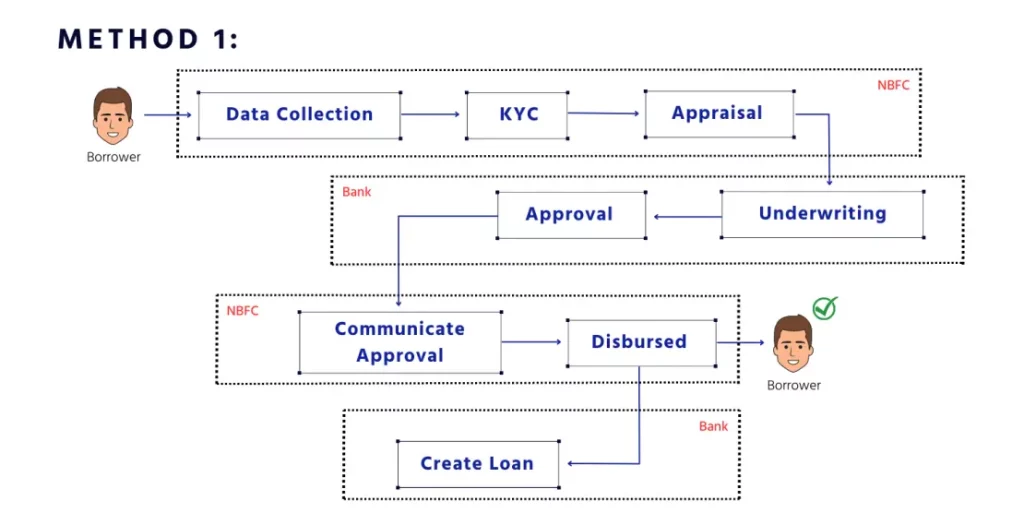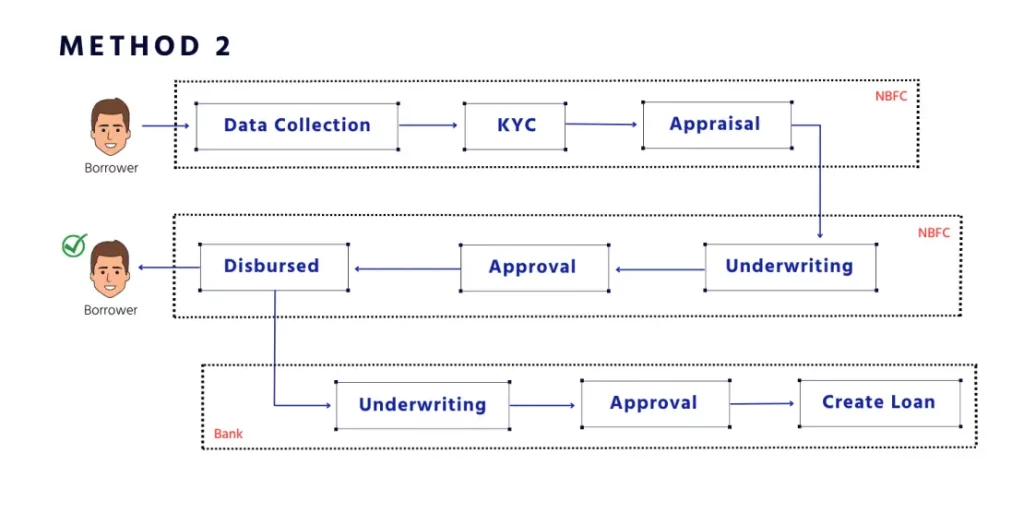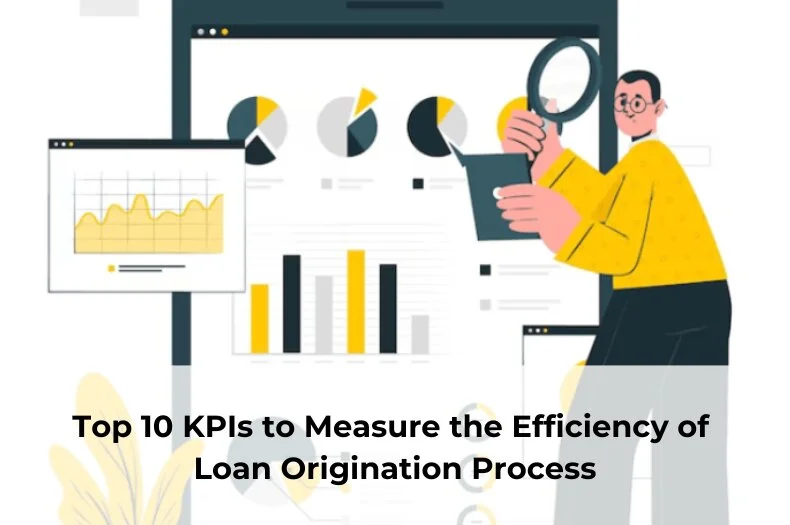Co-Lending Software
Revolutionizing the co-lending infrastructure ecosystem, transforming it for everyone's benefit.


Lend Together for A Better Future
Building a co-lending platform-as-a-service for lenders for a better financing option. Our co-lending software offers a technology-driven solution for financial institutions seeking to expand their businesses by tapping into this credit product.
What’s in it for you?
- Enabling to reach priority sector lending goals via the co-lending partnership and diversifying customer base.
- Improving cash flows and margins for small lenders by accessing low-cost and reliable funds from large lenders.
- Improving the efficiency and speed of lending processes by automating and digitizing the entire co-lending process.
- Creating synergies between co-lending partners by allowing them to share their data, insights, and best practices.
Partner with multiple lenders now and give loans easily to your borrowers!
How Does This Work?
A fully automated and hassle-free platform integrated with multiple APIs to redefine the co-lending process for lenders.


Benefits of Co-Lending
For Co-Lenders
- Seamless Collaborating Platform: A secured platform for collaboration with multiple lenders.
- Better Risk Assessment: Sharing risk exposure among the co-lenders and enhancing risk mitigation.
- Improve Borrower Acquisition.
- End-to-End digital lending software: Effortless integration of loan origination system and comprehensive end-to-end lending cycle management.
- Enhance data-sharing between lending partners.
- Flexible to suit different underwriting processes.
- Easily Configurable & Integrated with multiple APIs.
- Better Decision-Making Ability: Make informed decisions with our automated credit decision-making solution.
- Seamless Loan Management: Manage repayment, part payments, and foreclosures seamlessly across all repayment schedules.
- Better Returns: Better returns to diversify loan portfolios and invest in a broader range of loans.
- Improve efficiency: Streamline the lending process and reduce administrative costs.
- Access to New Markets & Geographies: Allowing lenders to expand their reach and increase their customer base.
- Regulatory Compliance: Stay compliant with regulatory requirements and ensure loans are made in accordance with relevant laws and regulations.
For Borrowers
- Better Rates: Lower interest rates by accessing funding from multiple lenders.
- Faster & Higher Approval Rates: Improve your chances of getting faster loan approvals.
- Flexibility: Gives you more options for repayment terms and loan amounts.
- Increased transparency: Get transparent loan terms and conditions, making it easier to understand the details of loans and take informed decisions.
- More personalized service: More customisable service and support, helping to navigate the loan application process and offering tailored loan products to meet your needs.
- Greater financial inclusion.
- Access to formal credit facilities.
What Our No-Code-Low-Code Platform Offers?
Define the co-lending partnership ratio for funding
Define different loan products with classifications as secured and unsecured
Rule Engine Configuration
Multiple API Integration
Integrating Loan Origination/Loan Servicing System
Create Loan Management System
Supports n-number of lenders.
Generate repayment schedules for borrowers and synchronise with multiple lenders.
Define product-wise lenders and their lending parameters & automatically calculate the weighted interest rate.
Define multiple charges and sharing ratios.
Ability to foreclose, receive part payment, advance EMI.
Ability to easily write off loans.
Easily create templates for the loan agreement, SMS & EMI.
Display lender-relevant information for transactions.
Supports analytical lender-wise reporting.
Want to discover what we can offer?
Frequently Asked Questions
How does the co-lending model work?
As per the RBI on the co-lending model, banks and NBFCs can co-lend to priority sector borrowers in a way that the loan is shared between the two lenders as per a pre-agreed formula. The co-lending banks are required to maintain an appropriate level of risk participation in the loans originated through the co-lending arrangement. The NBFC shall retain a minimum of 20% share of the individual loans on their books, and the risk-sharing ratio between the bank and the NBFC shall be as per their agreement. The co-lending banks shall be required to maintain their respective portfolio in their books. The co-lending model is expected to leverage the comparative advantages of banks and NBFCs in a collaborative effort to improve the flow of credit to priority sector borrowers while leveraging the technology-driven platforms of the NBFCs.
What is a co-lending platform?
A co-lending platform facilitates availing a loan that benefits all parties involved - borrower, larger lender, and smaller lender. Borrowers can obtain loans at a reduced & affordable rate. Larger lenders can access a broader range of borrowers, extending their reach into unserved and underserved sectors. Smaller lenders can maintain a consistent and dependable flow of cost-effective funding. Consequently, this approach promotes financial inclusivity and accelerates lending sector growth.
Related Articles
- Email: salesteam@cloudbankin.com
- Sales Enquiries: +91 9080996606
- HR Enquiries: +91 9080996576



After smartphone penetration, people are not watching their SMS at all. They use SMS only for OTP related transactions. That’s it.
But What can a Lender see in your SMS after you consent to them?
Lender can see income, expenses, and any other Fixed Obligation like (EMIs/Credit Card).
1) Income – Parameters like Average Salary Credited, Stable Monthly inflows like Rent
2) Expenses – Average monthly debit card transactions, UPI Transactions, Monthly ATM Withdrawal Amount etc
3) Fixed Obligations – Loan payments have been made for the past few months, Credit card transactions.
It also tells the Lender the adverse incidents like
1) Missed Loan payments
2) Cheque bounces
3) Missed Bill Payments like EB, LPG gas bills.
4) POS transaction declines due to insufficient funds.
A massive chunk of data is available in our SMS (more than 700 data points), which helps Lender to make a credit decision.
#lendtech #fintech #manispeaksmoney